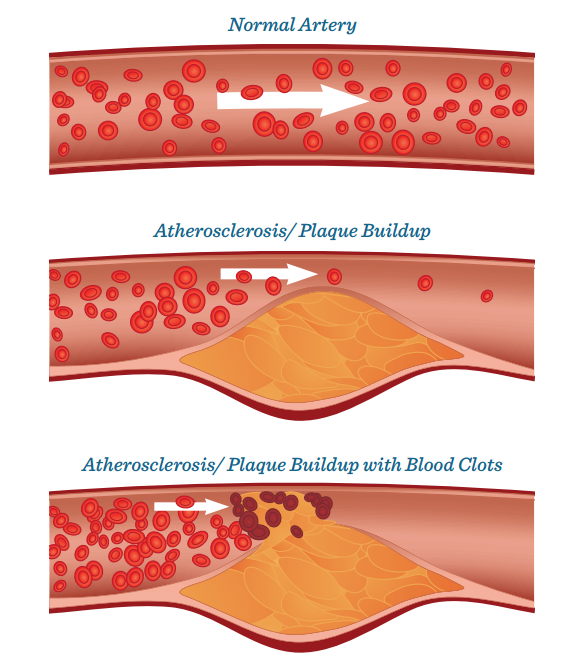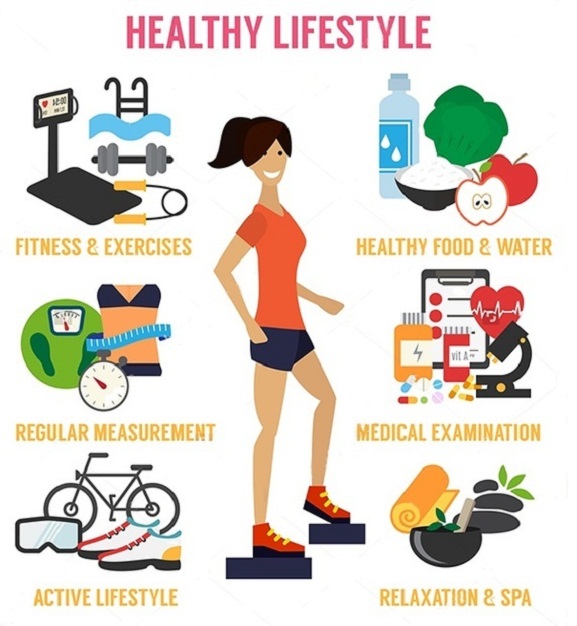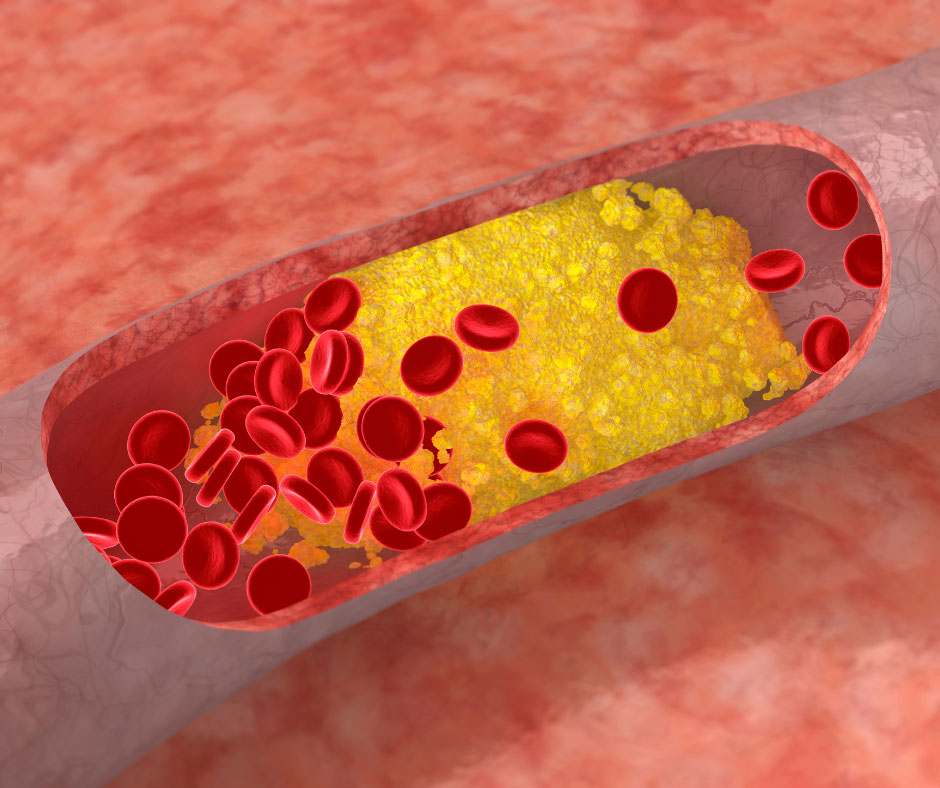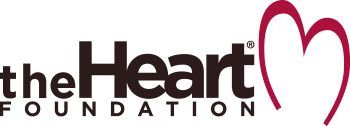Healthy arteries are flexible and elastic, but as we age, the walls in our arteries can harden. Arteriosclerosis is a general term for the thickening and hardening of arteries. Atherosclerosis is a type of arteriosclerosis. The name atherosclerosis comes from the Greek words athero (meaning gruel or paste) and sclerosis (hardness). Atherosclerosis is the narrowing of an artery because of plaque buildup. Plaque is a sticky substance made up of fat, cholesterol, cellular waste products, and calcium. As plaque builds up, the diameter of the artery narrows, which can restrict blood flow and decrease the oxygen supply to the body. The plaque buildup in your arteries can be compared to a plumbing problem. When sludge forms on the inside of a pipe, it causes a clog or a blockage.
What causes atherosclerosis and how does it progress?
Atherosclerosis and the hardening of the arteries are fairly common problems associated with aging. Atherosclerosis is a slow, progressive disease that may start in childhood, but usually doesn’t become apparent until middle or old age. Although the exact cause is unknown, atherosclerosis may start with damage to the innermost wall of an artery (called the endothelium). Once the inner wall of an artery is damaged, blood cells and plaque accumulate at the injury site. Over time, the plaque build ups and hardens, and the diameter of your artery become more and more narrow.
When plaque builds up, two things can happen. One is that a piece of plaque may break off and be carried along by the bloodstream until it gets stuck. The other is that a blood clot (a thrombus) may form on the plaque’s surface. If either of these happens, the flow of blood could be blocked in an artery in the heart, brain, pelvis, legs, arms or kidneys and cut off the supply of oxygen. If a blood clot completely blocks the blood flow, or even breaks apart, it can trigger a heart attack or stroke.
The complications of atherosclerosis depend on which arteries are blocked. If the oxygen supply to the heart muscle is reduced, a heart attack can occur. If the oxygen supply to the brain is cut off, a stroke can occur. If the oxygen supply to the arms or legs is blocked, it can result in gangrene (tissue death). If the oxygen supply to the kidneys is blocked, the result could be chronic kidney disease or kidney failure. Atherosclerosis can also cause an aneurysm – an aneurysm is a bulge in the wall of your artery. If an aneurysm bursts, you may face life-threatening internal bleeding. Although this is usually a sudden, catastrophic event, a slow leak is possible. If a blood clot within an aneurysm dislodges, it may block an artery at some distant point.
Certain traits, conditions, or habits can cause and may raise your risk for atherosclerosis. Following are the risk factors that commonly cause damage to the arterial wall:
- Elevated levels of cholesterol and triglycerides (a type of fat) in the blood.
- High blood pressure.
- Smoking and other sources of tobacco: Cigarette smoke greatly aggravates and speeds up the growth of atherosclerosis. It makes plaque more likely to form and to grow bigger and faster.
- High amounts of sugar in the blood due to insulin resistance or diabetes.
- Inflammation from diseases, such as arthritis, lupus or infections.
- A family history of early heart disease.
- Not exercising regularly.
- An unhealthy diet.
Symptoms
Atherosclerosis develops gradually and you will probably not have symptoms until an artery is so narrowed or clogged that it can’t supply adequate blood to your organs and tissues. Early symptoms of atherosclerosis may include mild dizziness, light headedness, vertigo, palpitations and blurred vision. More severe symptoms depend on which arteries are affected:
- If you have atherosclerosis in your heart arteries, you may have symptoms such as chest pain or pressure (angina), pain in the abdomen, shoulders, back, neck, arms, and jaw, shortness of breath, perspiration, lightheadedness, nausea or vomiting, or a sense of impending doom.
- If you have atherosclerosis in the arteries leading to your brain, you may have symptoms such as sudden numbness or weakness in your arms or legs, difficulty speaking or understanding speech, temporary loss of vision in one eye, drooping muscles in your face, or a sudden, severe headache.
- If you have atherosclerosis in the arteries in your arms and legs, you may have pain in your legs when walking.
- If you have atherosclerosis in the arteries leading to your kidneys, you may develop high blood pressure, swelling of the hands and feet, or difficulty concentrating.
Pay attention to early symptoms of inadequate blood flow, such as chest pain, leg pain, numbness, swelling, or shortness of breath. If you think you have atherosclerosis, talk to your doctor. A diagnosis will be based on a physical exam, blood tests, and possibly an ultrasound or a CT scan. Early diagnosis and treatment can stop atherosclerosis from worsening and prevent a heart attack, stroke or another medical emergency.
Prevention and Treatment
Atherosclerosis can be prevented and many successful treatment options exist. A healthy lifestyle is recommended both to prevent and to treat atherosclerosis . A healthy lifestyle includes:
- Quitting smoking – Smoking raises blood pressure and is one of the major risk factors for atherosclerosis.
- Eating healthy foods – Eat a Mediterranean diet that is rich in whole grains, and fruits and vegetables. Avoid salty and sugary foods, saturated and trans fats, and processed foods.
- Exercising regularly – Exercise keeps your heart muscle strong and your blood flowing.
- Maintaining a healthy weight.
- Monitoring your blood pressure and your cholesterol levels.
Medications are also used to treat atherosclerosis. Medications include:
- Cholesterol-lowering medications, including statins and fibrates.
- Antiplatelet drugs and anticoagulants, such as aspirin, to prevent blood from clotting.
- Beta blockers, calcium channel blockers, or diuretics to lower your blood pressure.
- Angiotensin converting enzyme (ACE) inhibitors, which help prevent narrowing of your arteries.
If symptoms are extremely severe, surgery may be necessary. Different surgeries include:
- Bypass surgery – A vessel from somewhere else in your body or a synthetic tube is used to divert blood around your blocked or narrowed artery.
- Thrombolytic therapy – A blood clot is dissolved by injecting a drug into the affected artery.
- Angioplasty – A thin, flexible tube called a catheter and a balloon are used to expand your artery. Sometimes a stent is inserted to leave the artery open.
- Endarterectomy and atherectomy – Surgical procedures used to remove plaque buildup inside an artery.
Benjamin Franklin said, “An ounce of prevention is worth a pound of cure.” It’s never too late to make healthy lifestyle changes, such as quitting smoking, eating healthy foods and becoming more physically active. A healthy lifestyle is the primary line of defense against atherosclerosis and its complications, including heart attack and stroke.
References:
American Heart Association: https://bit.ly/2Jg9mXb
Mayo Clinic: https://mayocl.in/2zh9eBP
National Heart, Lung and Blood institute: https://bit.ly/2CEA1Xa








